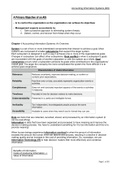Accounting Information Systems (AIS)
A Primary Objective of an AIS
• Is to control the organisation so the organisation can achieve its objectives
• Management expects accountants to;
I. Take a proactive approach to eliminating system threats;
II. Detect, correct, and recover from threat when they occur.
Chapter 1 Accounting Information Systems: An Overview
System is a set of two or more interrelated components that interact to achieve a goal. Most
systems are composed of smaller subsystems that support the larger system.
Each subsystem is designed in such a way it achieves one or more of the organisational goals.
Changes in subsystem can a ect other subsystems. Goal con ict is when a subsystem’s goals
are inconsistent with the goals of another subsystem or with the system as a whole. Goal
congruence occurs when a subsystem achieves its goals while contributing to the organisations’
overall goal. The larger the company the more complicated the system the more di cult it is to
achieve goal congruence.
Characteristics of Useful Information
Relevance Reduces uncertainty, improves decision-making, or con rm or
corrects prior expectations.
Reliability Free from error or bias; accurately represents organization events or
activities.
Completeness Does not omit (exclude) important aspects of the events or activities
it measures.
Timeliness Provided in time for decision makers to make decisions.
Understandability Presented in a useful and intelligible format.
Veri ability Two independent, knowledgeable people produce the same
information.
Accessibility Available to users when they need it and in format they can use.
Data are facts that are collected, recorded, stored, and processed by an information system (it
can be everything).
Information is data that have been organised and processed to have meaning and improve the
decision-making process. You have to understand something for it to be information and this is to
provide meaning!
When human beings experience information overload is when the amount of information
exceeds the amount the human mind can absorb and process, resulting in a decline in decision
making quality and an increase in the cost of providing information. So, nowadays, we use
Information Technology (IT) to help decision makers lter more e ectively and condense
information.
Bene ts of Information
Costs of producing Information -/-
Value of Information
Page 1 of 25
fi fi
ff fi fi fl ff ffi






